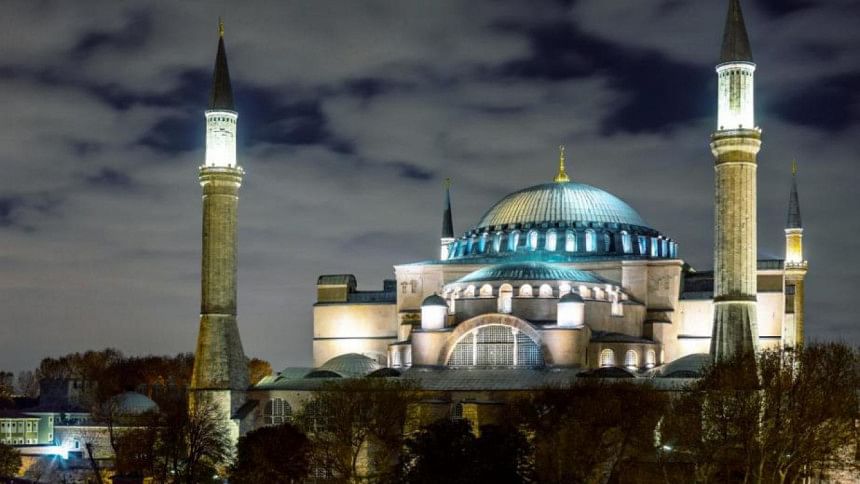Ayasofia: A lost symbol of a shared heritage

I was living on the Greek island of Crete in March 2018 when I heard of the Turkish President Erdogan reciting verses from the Quran at the iconic Hagia Sophia in Istanbul. The Greek were in a state of agitation and every little kafenio or road side cafe had their TV channels tuned in to the news and it was a barrage of heated words and elaborate gestures at their neighbouring country's activities.
I too grew pensive at the collective atmosphere as most Greeks I encountered, expressed sheer passion towards the Hagia Sofia, considered one of the greatest symbols of the Greek Orthodox Church. A country littered with remnants of the Byzantinian era, the Greeks have eulogies and songs honouring Hagia Sofia, dating from the times it was built. Many Greeks have been wanting its conversion back into a church but then there were those, who loved it for the inter-faith harmony that it exuded. As a graduate of Heritage Management, my only concern was losing the integrity and authenticity that the status of a museum brought to a site of such cultural and historical significance.
Hagia Sofia saw many changes and additions and even functioned as a Catholic church for a short duration then went back to being a Greek orthodox church, until its final conversion into a mosque, as the Ottomans conquered Constantinople in 1453 CE. By the time of Kemal Ataturk's secular Turkey, the city was known as Istanbul and the mosque, Ayasofia. For the first time since the Ottomans, the red carpets covering the artwork on the floors were uncovered and Ataturk declared it a museum in 1934. In July 2020, President Erdogan saw to its conversion back into a mosque and Ayasofia held its first mass Friday prayers in more than 80 years on July 24, 2020.
This conversion had been in the offing for a few years, but I suppose we were all hoping against it as the popular opinion was that a UNESCO World Heritage Site would surely be subject to more stringent measures. It needs to be noted that this is not the first Byzantinian church being converted into a mosque by Erdogan but the fact that he went for a site so internationally recognisable as a symbol of Turkey, was what set this move apart. The Taj Mahal is to India what Ayasofia is to Turkey and so much more. Once considered the largest dome in the world, Ayasofia remains a symbol of the harmony that Turkey exudes: a merging of the East and West, a coming together of inter-connected faiths that a country like Turkey, with its many rulers and colourful history can only result in.
The move itself has many implications from political to rousing of religious fervour, both motivations which should be kept away from a heritage site of such international significance. UNESCO could do little to stop this move except express their disappointment but the carpets have rolled back on to the floors of the mosque and the symbols covered in cloth during prayer times. Turkish authorities have assured maintaining it as a museum, without an entrance fees and allowing entry for people of all religions, but it remains to be seen how the changes will be applied.
Ayasofia has been repaired multiple times over its 1,500-year presence and the Fossati brothers in the 19th century added placard discs with the names of Allah, the Prophet, his two grandsons and the 4 Caliphs. Sketches were made of all the mosaics but these were later covered for their protection from vandals, but also because locals had expressed their displeasure, since it operated as a mosque back then. With its status reverted back as a mosque, any changes would still be noticeable but to what extent these changes are done, is of concern.
Ayasofia's influence on the Muslim world has been more architectural than spiritual as many mosques, are influenced by the Ottoman style of architecture. This credit mainly goes to the famed architect Sinan, who built the Selimiye Mosque in 1575 CE and all later influences are thus, an offshoot of Sinan's greatest inspiration: the Hagia Sofia.
Evangelos Kyriakidis, director of the Chicago-based Heritage Management Organization explains that "there is no punishment, and the worst that can happen is that [UNESCO] revokes the world heritage status. A travel warning that you are going to a country that does not look after world heritage could be damning, but it is very hard for [UNESCO] to do that because it needs the money of the parties that are involved -- in this case Turkey."
In a world where we have witnessed rampant losses incurred by mindless acts of terrorism and the more recent refusal to accept the whitewashing/ colonisation of our histories (the tearing down of white supremacist statues), this is the time we need to most preserve what is left of our shared heritage. Ayasofia gave us a chance to relive the Constantinople of the 6th century CE and the later day Ottomans. The influence of the Ottomans to the East and the Byzantinians to the West, congregated under the domed roof that was thought to be held by a golden string from the heavens.
The writer has an MA in Heritage Management from the University of Kent (UK) and Athens Institute of Economics and Business and works as a communications consultant for an international development organization in Bangladesh.
[Dr Kyriakidis in an interview to the Smithsonian Magazine dated: July 13, 2020.]

 For all latest news, follow The Daily Star's Google News channel.
For all latest news, follow The Daily Star's Google News channel. 



Comments